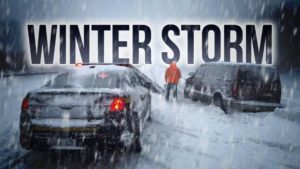
Ban Will Be in Effect Beginning 3PM on Saturday and Will Remain in Effect for Duration of Storm
Urges Motorists to Avoid Travel During This Period to Allow Crews to Clear Roads
Governor Andrew M. Cuomo has directed the New York State Department of Transportation and the Thruway Authority to ban tractor trailers and buses on the entire Thruway system, with the exception of I-95 in Westchester and Bronx counties, and most interstate highways out of an abundance of caution as winter storm Harper will impact travel across the entire state this weekend. The ban will be in effect beginning 3:00 p.m. on Saturday and will last for the duration of the storm.
“Safety is our number one priority and with the anticipated storm impacting most of New York State, we are implementing this ban on tractor trailers and buses so our plow operators, fire, law enforcement and emergency personnel can keep roads clean and respond to emergencies as quickly as possible,” Governor Cuomo said. “I am also urging drivers to stay off the roads unless absolutely necessary.”
Tractor trailers and buses will be banned from the following interstate highways:
DOT Highways:
- I-88 from Binghamton to Albany
- I-86/Rt 17 from PA border to I-87 (entire length)
- I-81 from PA Border to Canadian Border
- I-84 from PA Border to CT Border
- I-684 from I-287 to I-84
- I-87 from Albany to Canadian Border
- I-390 from I-86 to I-90
- I-99 from PA Border to I-86
- I-90 from Thruway Exit 24 to Berkshire Spur Exit B2 (through Cap Dist)
- Rt 219 from Peters Rd to I-90 (expressway section)
- I-190 – full length (both Thruway and DOT sections)
- I-290 – full length
- Rt 5 Skyway – I-190 to NY179 (Milestrip Rd)
- Rt 400 – NY16 to I-90
- I-390, I-490, I-590 around Rochester
- Alternate Route 7 in Albany County
Thruway highways:
- I-90 from PA line to Albany (Int. 24)
- I-87 from Albany (Int. 24) to NYC line
- I-287 (from Suffern to I-95)
- Berkshire Spur from the Thruway Mainline to the Mass line
DOT and the Thruway Authority are actively coordinating traveler information and potential vehicle restrictions with partners at TRANSCOM, NJDOT, CTDOT, and PennDOT. New Jersey and Pennsylvania have announced travel bans.
Anticipated Weather
New Yorkers should expect a general 12 to 24 inches of snowfall throughout Upstate New York over the weekend with Winter Storm Warnings across all of Upstate. The storm will begin to roll in from the southwest Saturday morning and overspread the State Saturday afternoon into evening. The heaviest of the snowfall will be overnight Saturday through the day Sunday. Snowfall forecasts have remained the same with the majority of Upstate set to receive 14 to 20 inches and a portion of the Capital Region receiving up to 24 inches. Snow will linger into Monday with gusting winds causing blowing snow conditions.
New York City can expect three to six inches of snowfall before a transition to rain Saturday evening. On Long Island, two to five inches of snowfall can be expected before it transitions to rain. In the Mid-Hudson Region, the precipitation will transition from all snow to a mix of snow, rain, and ice pellets. The remainder of the State is expected to remain all snow. Winds gusts may reach 35 m.p.h. at times as the system moves through.
Downstate areas will see the transition to rain early in the morning Sunday, which will help to melt away some of the snow in New York City and on Long Island. In the Mid-Hudson Region, the transition from snow will not be as clean as downstate, which will lead to a mix of precipitation types before the transition back to snow.
Safe Travel
During these storms, New Yorkers should also expect to see slippery road conditions, as well as blowing and drifting snow during the Thursday evening and Friday morning commutes, as well as over the course of the weekend. Drivers are being urged to travel only when necessary and to do so with extreme caution.
Some of the most important tips for safe driving include:
- When winter storms strike, do not drive unless necessary.
- Use caution on bridges as ice can form quicker than on roads.
- Wet leaves on roadways can cause slippery conditions, making it important to drive at slower speeds when approaching patches of them.
- If you must travel, make sure your car is stocked with survival gear like blankets, a shovel, flashlight and extra batteries, extra warm clothing, a set of tire chains, battery booster cables, quick energy foods and brightly colored cloth to use as a distress flag.
- Do not attempt to drive over flooded roads; turn around and go another way. Water moving at two m.p.h. can sweep cars off a road or bridge.
- Watch for areas where rivers or streams may suddenly rise and flood, such as highway dips, bridges and low areas.
- If you are in your car and water begins to rise rapidly around you, abandon the vehicle immediately.
Additionally, the leading cause of death and injuries during winter storms is transportation accidents. Before getting behind the wheel, ensure that your vehicle is clear of ice and snow; good vision is key to good driving. Plan your stops and keep more distance between cars, be extra alert, and remember, snowdrifts can hide smaller children. Moreover, always match your speed to the road and weather conditions.
It’s important for motorists on all roads to note that snowplows travel at speeds up to 35 m.p.h., which in many cases is lower than the posted speed limit, to ensure that salt being dispersed stays in the driving lanes and does not scatter off the roadways. Oftentimes on interstate highways, snowplows will operate side by side, as this is the most efficient and safe way to clear several lanes at one time.
Motorists and pedestrians should also keep in mind that snowplow drivers have limited lines of sight, and the size and weight of snowplows can make it very difficult to maneuver and stop quickly. Snow blowing from behind the plow can severely reduce visibility or cause whiteout conditions. Motorists should not attempt to pass snowplows or follow too closely. The safest place for motorists to drive is well behind the snowplows where the roadway is clear and salted.
Safety in Extreme Cold
Dress for the Season
- Wear loose, lightweight, warm clothing in several layers. Trapped air between the layers acts as an insulator. Layers can be removed to avoid perspiration and subsequent chill. Outer garments should be tightly woven, water repellent and hooded.
- Always wear a hat or cap on your head since half of your body heat could be lost through an uncovered head.
- Cover your mouth with a scarf to protect your lungs from extreme cold.
- Mittens, snug at the wrist, are better than gloves because fingers maintain more warmth when they touch each other.
Physical Exertion
Winter storm conditions and cold waves are the deadliest types of weather as cold temperatures put an extra strain on your heart. Heavy exertion, such as shoveling snow, clearing debris or pushing a car can increase the risk of a heart attack.
To avoid problems, remember these tips:
- Stay warm, dress warm and SLOW DOWN when working outdoors.
- Take frequent rests to avoid over exertion.
- If you feel chest pain — STOP and seek help immediately.
Hypothermia
Prolonged exposure to cold temperatures can cause hypothermia, especially in children and the elderly.
Watch for these symptoms:
- Inability to concentrate
- Poor coordination
- Slurred speech
- Drowsiness
- Exhaustion
- Uncontrollable shivering, followed by a sudden lack of shivering
If a person’s body temperature drops below 95 degrees Fahrenheit, get emergency medical assistance immediately. Remove wet clothing, wrap the victim in warm blankets and give warm, non-alcoholic, non-caffeinated liquids until help arrives.
Frostbite
People working or playing outdoors during the winter can develop frostbite and not even know it. There is no pain associated with the early stages of frostbite, so learn to watch for these danger signs:
- First, the skin may feel numb and become flushed. Then it turns white or grayish-yellow. Frostbitten skin feels cold to the touch.
- If frostbite is suspected, move the victim to a warm area. Cover the affected area with something warm and dry. Never rub it!
- Then get to a doctor or hospital as quickly as possible.

